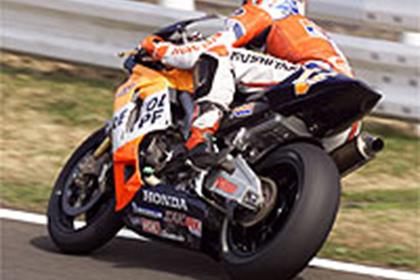Honda V5 GP bike breaks cover
THESE are the world’s first action pictures of the all-new four-stroke Honda Grand Prix bike destined to start racing in 2002.
The shots of the V5-engined bike were taken at Sugo in Japan today, where the bike was being track tested for the first time. The firm will field the bike in GPs next year when four-strokes of up to 990cc are allowed to race against the existing 500cc two-strokes.
The bike, codenamed the RC-V, was painted in the same Repsol colours of the official Honda 500 GP team and ridden by test-rider Manabu Kamada. He completed 22 laps aboard the bike, with a best circuit of 1:34.0, well outside the 1:29.96 lap record set in the Sugo WSB races last year.
Details of the bike are still scarce, with Honda refusing to allow journalists or photographers into the paddock or pits area when the bike was worked on – meaning some of the juiciest details of what exactly is under the fairing are still unknown.
We know the engine is a water-cooled V5, with cylinders in three-forward/two-backward formation, but that’s about it.
The exact capacity is still secret, as is the firing order of the engine or how Honda have balanced it, but a clue to both of those questions comes in the reported sound of the engine: despite having more than twice as many cylinders as something like a VTR1000 SP-1, observers said it sounded just like a massive V-twin.
This could mean that Honda are firing each bank of cylinders separately, with the front three in one big bang and the rear two in a smaller bang, and adding a balance shaft to the rear two-cylinder bank to balance it against the front trio.
The bike features a single high-level silencer exiting on the right, in contrast to the works SP-1s in WSB which feature twin silencers. It is also fitted with GP-spec running gear, such as Nissin six-pot calipers and carbon brakes, but it’s not the trickest stuff available. It doesn’t use the radial-style calipers which are now de rigeur on most works race bikes, for example, while the front Showa forks look like generation-old 2000-spec items.
The swingarm is a different kettle of fish entirely. Much bigger than the current works NSR500 or SP-1 items, it’s not built just for show: if power figures well in excess of 200bhp that bikes like this are supposed to produce are true, it’ll be needed.
The frame also looks different to the NSR and SP-1 items, something of a mix between the two. The bike appears taller than either bike and seems to hold the engine far higher than either of them.
Some views show unusual piping and metalwork under the seat and engine, leading to speculation that Honda have moved some parts such as the water pump, fuel tank, and cooling parts either under the engine or to other unusual locations on the bike to try and compensate for a high centre of gravity.
Honda tried fitting the fuel tank underneath the engine on the first oval-pistoned NR500 GP bikes, while the 1984-spec NSR500 two-stroke also featured an underslung fuel tank so the c-of-g was lowered and handling speeded up. Raising the engine in the frame also has an effect on traction exiting corners and peeling into turns under braking because of the increased forward and backward pitching of the chassis. Not all of it is beneficial however, and it’s things like these which Honda will be eager to get right as soon as possible – it’s pointless putting a 210bhp motor in something that can’t go round corners.
At last weekend’s Japanese GP at Suzuka, Yamaha revealed more details of its own four-stroke GP bike, the YZR-M1, while Swiss Formula One engine builder Sauber also unveiled its three-cylinder bike motor to the public.
The new V5 Honda will continue testing tomorrow.


